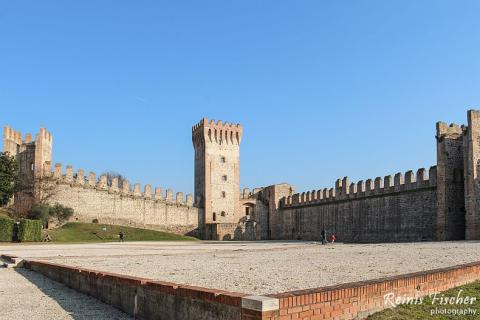It was January 1st, 2016 when we visited Castle Carrarese of Este, during our drive from Venice to Modena. It was our second stop after we enjoyed a cup of cappuccino at lovely Candiana town. Read more: Bar Rialto in Candiana)
The castle overlooking the town of Este consists of large master towers and massive walls, about a kilometre long, which embraces the extreme southern edge of the Euganean Hills. This mighty monument bears witness to the important role that the territory of Este played in medieval times.

Castle Carrarese of Este
The oldest part of the fortification is located on the elevated side and consists of a circle of walls with the remains of a church and the foundations of a small tower, probably dating to the sixth century AD.
The first evidence of a real castrum in this place dates back to 1115 and connects to the judicial and defensive power of the territory of which the feudal family which took its name from Este was appointed.

Inside view
During the twelfth and early thirteenth century, the Este Marquis enlarged the fortress building a series of curtain walls and residential buildings. The Marquis's castle reached its zenith with Azzo VI, who became an important centre of troubadour culture. Poets, artists and jesters were accommodated in his court, where they sang the Marquis praises and of the beautiful daughter Beatrice.

Broken statues
The destiny of the castle changed abruptly because of the violent wars between the Guelph faction (which was guided by the Este family) and the Ghibellines, who besieged and damaged the fortification several times. In 1249 the castle was destroyed by Ezzelino III da Romano, who then decided to restore it, but in 1294 the Paduan family, now undisputed masters of the land, demolished it again.
The current configuration of the castle dates back to 1339, when Ubertino da Carrara, lord of Padua, decided to build it in the shape that we see today.
At the beginning of the fifteenth century, after the spontaneous surrender of the city to the Republic of Venice, another wall which encompassed all the new urban centre of Este, already bounded by the channel Bisatto, was erected.
Lost its military significance, in 1570, the castle was bought by the rich and powerful Venetian Mocenigo family, who began the construction of its palace on the south side of the Carrara fortification. Originally the grand palace was composed of two symmetrical buildings, which required the demolition of a pair of towers. The east wing, however, was destroyed by fire in the eighteenth century.

The City of Este bought the entire complex in 1887, allocating green spaces within the city walls and the surviving wing of the Palazzo Mocenigo to a public use.
Today the castle serves as a majestic backdrop of Carrara manicured public gardens, opened in 1915, full old trees, while the rooms of Palazzo Mocenigo host the prestigious collections of the Archaeological Atestino Museum.
- Used resources: Castle Carrarese of Este
